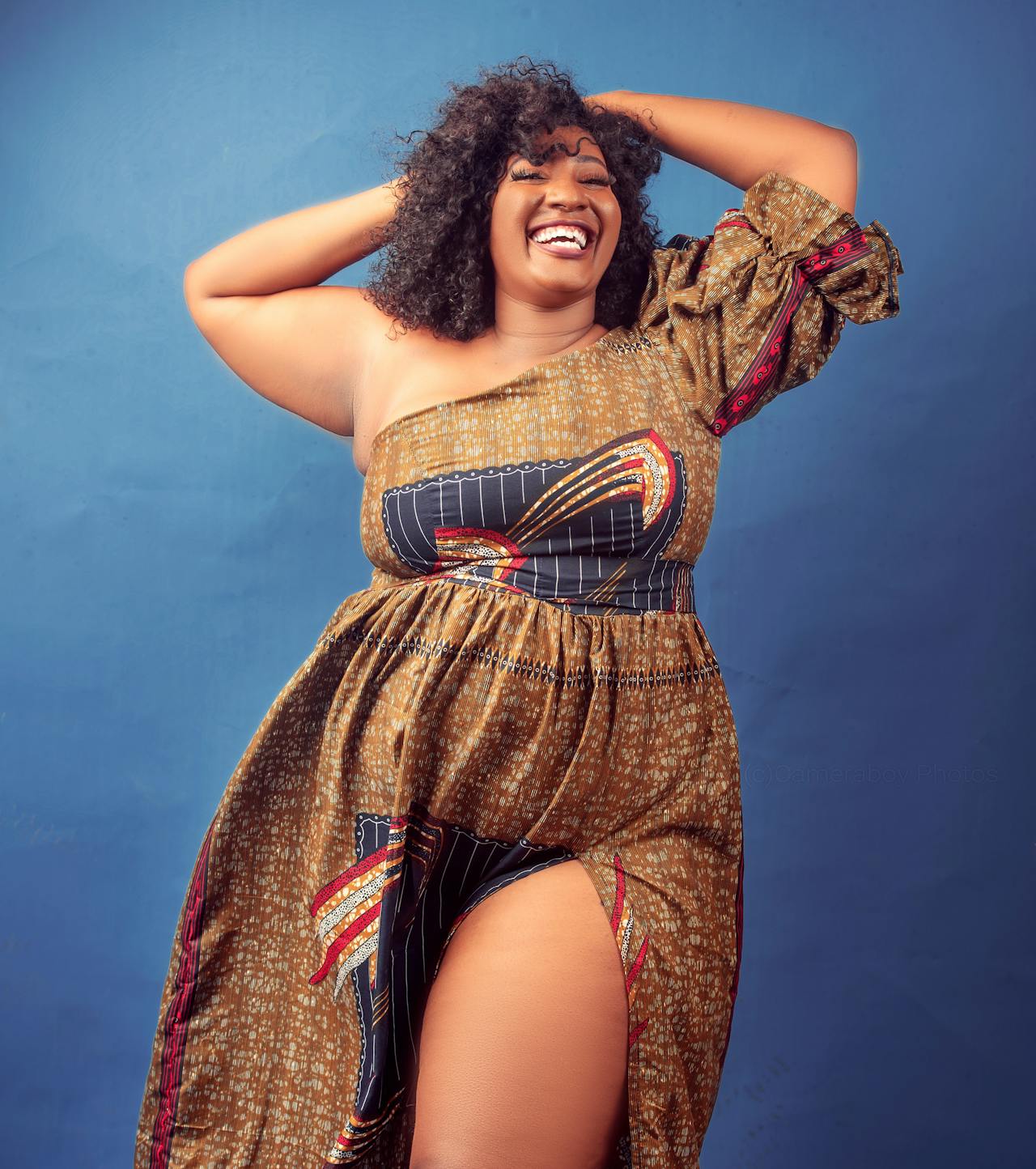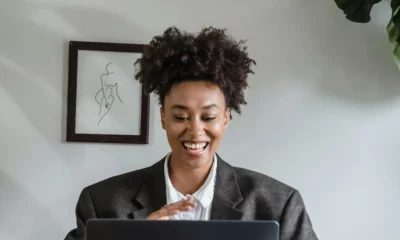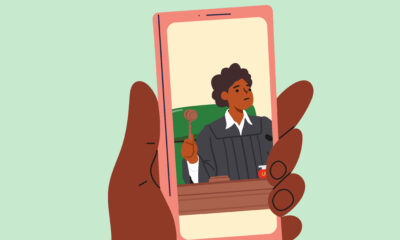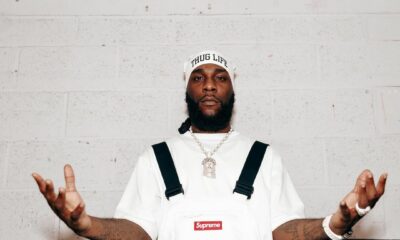Features
Ariyike Olayiwola: For Big Girls & The Rest of Us Who Don’t Fit In
…live free from the lifelong shackles of beauty standards that cause us to bend, squeeze, and twist like clay dolls.

One moment, you are strutting to the front of your mirror, posing from side to side, admiring the result of your one year of hard work at the gym. Six months later, you’d skulk around the mirror, fearfully avoiding the image you saw when you walked past a mirror put for sale by the neighbourhood carpenter. It had your face, a little puffy than usual, but still pretty. The body, however, didn’t look like yours. Well, not by the image you remember from the last time you gallantly stood in front of the mirror. This body had extra layers of fat on the tummy and arms. You’d later summon the courage to look and confirm that image to be you. Distraught by this truth, you try to intensify your workout, but can barely make it out of bed, thanks to your flaring hormones. They even overwhelm the result of a tailored diet, so you drape yourself in oversized shirts and boubou gowns and avoid mirrors thenceforth.
That was me some years ago struggling with accepting the reality of my body. Although I was never the ideal slim girl, I fell under the Nigerian “normal” body size and type for the longest time as an adult. You know, the flat tummy, moderately fleshy arms, and defined curves body type? That figure 8-ish body type. It was pretty cool having a body type that got me compliments. However, what particularly gladdened my heart about having this normal body size and type was that I was spared from the insensitive babbling of fatphobic people. Experiencing fatphobia as a teenager was traumatic; it wasn’t something I wanted to experience again. Unfortunately, I didn’t realise that I had been cloaked by the sheer callous comments made about my body so much that it became all I could see each time I stood in front of a mirror. I always had something to fix even as a normal size, so it wasn’t much of a surprise that I avoided mirrors and my body when I gained more weight and there was not much to do to appease my flaring hormones.
I thought I was alone until I chatted with a friend about body image issues. Like me, she had also developed a sort of phobia of looking at herself, only that hers was being in front of a camera and taking pictures. In her words, “Anytime I take a picture, I start to somehow hear echoes of people who had lectured me unsolicitedly about eating more, those who shame me to my face about not having the right curves. Those ‘model’ hype which, you’d know from their tone, that they are just being malicious. There is also that social media standard. So I delete or never post them; it’s not always I feel like dealing with uncouth people.”
This confession came as a shock to me as I had always considered her to be stunning; having that slim, tall body type, with a perfect oval face to match it. I never would have imagined such a beauty being skinny-shamed or having insecurities about her body.
As I pondered on this and the insensitivity of certain people, it became more concerning how these comments in conjunction with social media illusions, and the general media idealism of women’s bodies may be forcing insecurities upon us women. In curiosity, I opened a chat session with my small tribe of women using my WhatsApp status, and from the responses, it turned out I wasn’t paranoid. From feeling insecure about certain facial features to having a burst-to-hip ratio that isn’t media-acclaimed, having FUPA, hip dips, more internalised fatphobia and skinny-shaming, to having short, fat, or tiny legs; we all spotted one flaw or the other when we looked into the mirror, took a picture, or posted on social media. We either subconsciously compared ourselves to an ideal or we were reminded that we do not fit an ideal; so we weren’t beautiful enough.
An older friend admitted that she wasn’t conscious of any issue with her legs until she posted a picture on Instagram one time and a commenter said, “If not for this your short leg, your hourglass shape for fine well-well.” It was one comment, yet she subconsciously found herself hiding her legs, using photography illusions or photo editing apps to elongate her legs. She did this for about two years before she realised it was shrinking her confidence.
These patterns are everywhere, sadly. Paying a little attention to women and beauty conversations driven on social media, celebrities’ picture posts and the comments under them, the increase in photo and beauty apps, and the recent trend of AI imagery would show how much we women are trying so hard to avoid our bodies. We have internalised these ideal standards and fostered insecurities about our bodies. Noxiously, the popularism of BBL and other body-enhancing procedures shows how we fault and ignore our natural body anatomy and genetics and obsess over this ideal.
This might not fully be of our volition as several studies have linked the connection between the media and the beauty industry to this conditioning. The media, for one, has always had a strong influence in shaping our perceptions of femininity and beauty. From the glossy magazines’ display of airbrushed models to traditional TV adverts, reality shows and movies celebrating celebrity women with certain body features, the media has perfected the art of constructing the image of the ideal beautiful woman. Now, with social media platforming non-celebrity women who already possess certain body features and the new wave of influencing, the media has become even more potent in creating obsessive desires and aspiration of these ideals within us. The supposed ordinariness of these women on social media, for instance, and the blurred lines between how they express themselves and their marketing skills, make it seem like we can transform our not-so-perfect bodies into this ideal. It also suggests that if we cannot do it, we are lazy, undisciplined, or irredeemably flawed.
It is this conditioning that manifests as a lack of confidence and self-loathing for some, and for others, it’s enough reason to troll and bully other women. While trolls, bullies, and the remainder of the mean-girl club may need to hone in on a more dignifying form of reflection, it would be valuable for us women to become reconciled to the fact that there is no definite ideal. If we took a drive through memory lane, we would realise how different ideals have been promoted and celebrated over the years, season by season, culture by culture. We’d also realise how malleable it has been. Nigerians and some other Africans, for instance, favoured plumpness before the interference of Western ideas in the 80s and 90s via the media. The late 90s-through-early 2000s saw the acceptance of the lepa body type — slender and tall. Then came figure 8 — the sensation that celebrated curvaceous women, irrespective of size. Now, we swoon over a somewhat sandwiched version of the Western slim ideal body and the curvaceous African ideal. We are all expected to have perfect big round breasts and buttocks, neatly set into an hourglass shape on a size 8 body. All without hip dips, love handles or any protrusion from the tummy area.
It’d be laughable if it weren’t so harmful. Perhaps, if we weren’t absorbed by the aesthetics of it, we could have taken the hint that these ideals are rooted in fantasy. How else do we explain the defiance of anatomy and the disregard for genetics and other biological factors? While it is unclear whose fantasy we are conforming to, it is evident how the beauty industry capitalises on this idealisation and commodifies our femininity. With the consumption of every advertisement selling the promise of the ideal body, we are condemned to a restless pursuit of an elusive ideal and faltering self-esteem.
It would also be beneficial if we learned to detach our looks from our sense of worth. However cliché this may sound, an action like this would not only shield us from the exploitative tricks of the beauty industry but would help us secure our self-esteem. I learned it the hard way. By shifting our focus from external appearances to internal qualities or achievements, we develop a sense of worth that is rooted in our inherent value as women or individuals. Having this kind of self-assurance empowers us to live free from the lifelong shackles of beauty standards that cause us to bend, squeeze, and twist like clay dolls per season, or on the whim of entrepreneurs.
This practice nudged me to embrace my unique features and authenticity. It particularly helped me recognize my recrudescent fleshy body as a badge of survival and not a flaw like it has been universally speculated. So, perhaps, if we women imbibe this practice, we can contribute to or effect a cultural shift that celebrates not just authenticity but a more diverse range of beauty that leaves no woman and her story behind.























